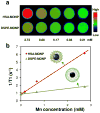Surface-engineered magnetic nanoparticle platforms for cancer imaging and therapy
- PMID: 21548618
- PMCID: PMC3166427
- DOI: 10.1021/ar200044b
Surface-engineered magnetic nanoparticle platforms for cancer imaging and therapy
Abstract
Enormous efforts have been made toward the translation of nanotechnology into medical practice, including cancer management. Generally the applications have fallen into two categories: diagnosis and therapy. Because the targets are often the same, the development of separate approaches can miss opportunities to improve efficiency and effectiveness. The unique physical properties of nanomaterials enable them to serve as the basis for superior imaging probes to locate and report cancerous lesions and as vehicles to deliver therapeutics preferentially to those lesions. These technologies for probes and vehicles have converged in the current efforts to develop nanotheranostics, nanoplatforms with both imaging and therapeutic functionalities. These new multimodal platforms are highly versatile and valuable components of the emerging trend toward personalized medicine, which emphasizes tailoring treatments to the biology of individual patients to optimize outcomes. The close coupling of imaging and treatment within a theranostic agent and the data about the evolving course of an illness that these agents provide can facilitate informed decisions about modifications to treatment. Magnetic nanoparticles, especially superparamagnetic iron oxide nanoparticles (IONPs), have long been studied as contrast agents for magnetic resonance imaging (MRI). Owing to recent progress in synthesis and surface modification, many new avenues have opened for this class of biomaterials. Such nanoparticles are not merely tiny magnetic crystals, but potential platforms with large surface-to-volume ratios. By taking advantage of the well-developed surface chemistry of these materials, researchers can load a wide range of functionalities, such as targeting, imaging and therapeutic features, onto their surfaces. This versatility makes magnetic nanoparticles excellent scaffolds for the construction of theranostic agents, and many efforts have been launched toward this goal. In this Account, we introduce the surface engineering techniques that we and others have developed, with an emphasis on how these techniques affect the role of nanoparticles as imaging or therapeutic agents. We and others have developed a set of chemical methods to prepare magnetic nanoparticles that possess accurate sizes, shapes, compositions, magnetizations, relaxivities, and surface charges. These features, in turn, can be harnessed to adjust the toxicity and stability of the nanoparticles and, further, to load functionalities, via various mechanisms, onto the nanoparticle surfaces.
Figures








References
-
- Xie J, Huang J, Li X, Sun S, Chen X. Iron oxide nanoparticle platform for biomedical applications. Curr Med Chem. 2009;16:1278–94. - PubMed
-
- Gao J, Gu H, Xu B. Multifunctional magnetic nanoparticles: design, synthesis, and biomedical applications. Acc Chem Res. 2009;42:1097–107. - PubMed
-
- Sumer B, Gao J. Theranostic nanomedicine for cancer. Nanomedicine (Lond) 2008;3:137–40. - PubMed
Publication types
MeSH terms
Grants and funding
LinkOut - more resources
Full Text Sources
Other Literature Sources

